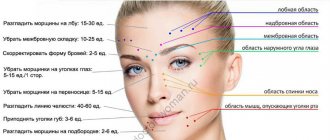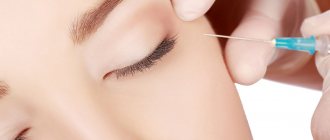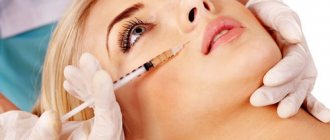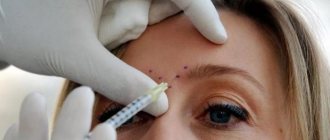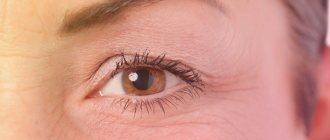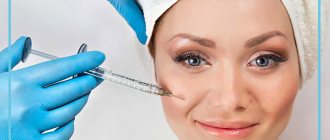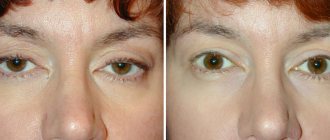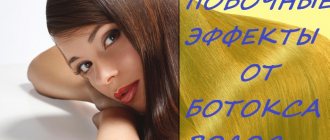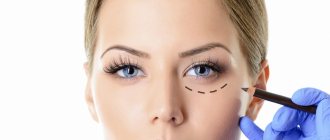Botox is a drug based on botulinum neurotoxin type A, which is produced by Allergan (USA). This word is also used to refer to all analogues of the drug. The botulinum toxin injection procedure gained popularity at the end of the last century and has since remained the most popular non-surgical anti-aging technique.
EFFECT OF BOTOX
The facial muscles have a peculiar anatomical structure: they are attached to the bone at one end, and the other end is woven into the skin.
Due to their location, the muscles, when contracting, move the skin, and certain emotions are displayed on the face.
Habitual emotions and increased tone of certain facial muscles lead to the formation of facial wrinkles.
Each muscle has nerve fibers that are responsible for transmitting nerve impulses from the brain to the muscle and causing its contraction. The active substance of Botox, botulinum toxin, after being introduced into muscle tissue, penetrates the endings of nerve fibers and blocks the transmission of nerve impulses. The muscles relax and stop stretching or wrinkling the skin, so wrinkles and creases are smoothed out.
Why is Botox harmful to the face?
We have already written more than once about the dangers of Botox for the face. Look for articles on the site. Let us briefly recall how botulinum poison disfigures one’s appearance:
- Numbness of the face.
A person acquires a mask-like face, devoid of facial expressions. Uncontrollable grimaces also often appear. - Bruises and ugly hematomas.
Inevitable, since blood vessels are damaged during injections. They may not go away for up to six months. - Terrible swelling and hernia of the eyelids.
Due to impaired muscle tone of the face, lymph flow suffers, and this leads to prolonged and extensive swelling. - New wrinkles and sagging skin.
Paralysis of the target muscle entails a restructuring of the muscular system. Neighboring muscles are forced to overstrain, performing the functions of their immobilized colleagues, which were not inherent in nature. The skin is now stretched not in the same way as before, but in other directions. As a result, new wrinkles appear next to the affected area, smoothed out for a couple of months, and the skin sags. - Sliding down the upper eyelids and eyebrows, inability to open the eyes.
The muscles that held the eyebrows and eyelids are now straightened, no longer compressed. And all this “beauty” falls on the eyes for several months, until the poison is removed. - Ugly bumps above the eyebrows.
Brow ridges appear in many people who have forehead Botox. This occurs due to the uneven effect of the drug on muscle fibers. The face takes on a stern look. - Facial asymmetry.
Most often, the mouth or eyebrows are bent. One of the options for the appearance of asymmetry is during the expression of emotions or other facial activity.
ANALOGUES OF THE DRUG
In addition to Botox, botulinum toxin-based drugs such as Dysport and Xeomin are now common on the cosmetic market. Basically, the drugs differ in the dosage of botulinum toxin and resistance to changing storage conditions.
Estimated consumption of Botox, Dysport, Xeomin
| Impact area | Botox | Dysport | Xeomin |
| Forehead | 5-30 units. | 15-90 units. | 10-20 units. |
| Between the eyebrows | 15-30 units. | 45-90 units. | 10-20 units. |
| Eye area | 10-20 units. | 30-60 units. | 16-24 UNITS |
| Nose area | 2-10 units. | 6-30 units. | 4-6 units. |
| Lip area | 4-16 UNITS | 12-48 UNITS | 2-4 units. |
| Neck, décolleté | from 60 units. | from 180 units. | from 60 units. |
| Axillary areas | 60-200 units. | 180-600 units. | 100-200 units. |
How does botulinum toxin work?
In youth, the skin is elastic, and small wrinkles that appear as a result of the movement of facial muscles are easily smoothed out. However, with age, elasticity decreases and wrinkles become deeper. In addition, facial muscles acquire the ability to fixate in one position. For example, if a person is used to frowning, the facial muscles are fixed in a constant spasmodic position. A person has to make a huge effort of will to give his face a friendly expression.
Botulinum toxin drugs block neuromuscular transmission. When Botox is injected into a muscle, its ability to contract is reduced. And when the muscle does not contract, the skin over it does not fold. Wrinkles are gradually smoothed out. In this case, the muscle does not atrophy, because the blood supply to it does not stop, which means that nutrients continue to flow to the muscle fiber.
Contrary to rumors, facial expressions after using drugs based on botulinum neurotoxin do not disappear, but simply become calmer and more controlled. The face will not turn into a mask and will not lose its expressiveness. You will still frown, smile, be surprised. Only longitudinal grooves will disappear on the forehead, deep folds on the bridge of the nose, “crow’s feet” around the eyes, and “marionette lines” between the nose and the corners of the lips. The skin will glow with health and youth!
INDICATIONS FOR ADMINISTRATION
Elimination and smoothing of wrinkles:
- Horizontal wrinkles on the forehead;
- Vertical wrinkles between the eyebrows;
- Oblique wrinkles on the bridge of the nose (they are also called “rabbit wrinkles”);
- Wrinkles at the outer corner of the eye;
- Upturned or low eyebrows;
- Pronounced nasolabial folds;
- Vertical and horizontal neck wrinkles;
- Treatment of hyperhidrosis, severe sweating of the palms, feet, and armpits;
- Non-surgical face lift, the so-called Botox lift.
CONTRAINDICATIONS
- Pregnancy and breastfeeding;
- Inflammatory processes and injuries to the skin at the site of Botox injection;
- Taking antibiotics, calcium supplements, anticoagulants;
- Drooping of the upper eyelid, fatty hernias of the eyelids;
- Individual intolerance to the components of the drug;
- Myasthenia;
- Severe myopia;
- Alcoholism;
- Age up to 18 years;
- Menstruation and a few days before it;
- Diseases of the liver and lungs, both acute and chronic;
- Early recovery period after any operations;
- Hemophilia and other blood diseases in which blood clotting is impaired;
- Herpetic rash on the lips.
Why is there no effect?
In some cases, the effect of Botox injections does not appear or is barely noticeable. This can happen for two reasons:
- due to individual characteristics, antibodies to botulinum toxin appeared in the body, which completely or partially neutralized the drug;
- taking antibiotics of some groups leads to the removal of botulinum toxin from the body.
Do you want great results from Botox injections? Contact OLA beauty centers. Leading cosmetologists in St. Petersburg, excellent working conditions, only original drugs, maximum care for each patient!
PREPARATION FOR THE PROCEDURE
The day before the procedure you cannot:
- Drink alcohol;
- Perform any work while bending over, even simple actions such as trying on shoes, washing floors, etc.;
- Attend massage sessions during which you will have to lie face down.
It is imperative to stop taking antibiotics and, if possible, anticoagulants.
Antibiotics and Botox are combined in the body, but can mutually influence the severity of each other's effects. Thus, tetracycline antibiotics can reduce the effect of Botox, while aminoglycosides increase the severity of muscle paralysis.
Anticoagulants can cause hematomas to form at injection sites. It is not life-threatening, but the bruising may limit the patient's normal activities and communication with other people for some time.
Is it possible to extend the result?
Follow all the cosmetologist's recommendations to get the maximum, safe and prolonged effect of the procedure.
We will consider the main recommendations below:
- Physical activity in the first 7-10 days after the session significantly reduces the effect of botulinum therapy.
- There are no additional jokes between the main courses! They will provoke the production of antibodies, which destroy the toxin and reduce its effect to a minimum.
- Avoid solariums, baths and saunas.
- Assess the compatibility of current pharmacotherapy with contraindications to botulinum therapy.
HOW IS THE PROCEDURE?
- After determining all indications and contraindications for the procedure, the patient gives informed consent to the procedure;
- On the patient's face, areas in which muscle tone is increased, which leads to the formation of wrinkles, are determined, and these areas are marked with a marker;
- For each area, mark the drug injection site with dots, circle the dots with a diameter of 1-1.5 cm (size of the drug distribution zone in the tissues around the injection site). The distribution zones must be in contact.
- The injection sites are cooled with ice or an anesthetic drug such as Emla is applied;
- Using an EMG device, the location of the syringe needle with the drug is determined exactly in the thickness of the muscle, and the drug is injected;
- In some cases, after removing the needle, the injection site is lightly pressed to prevent hematomas from forming, and pressed with gentle massage movements away from the eye area or other muscles located in this area so that the toxin acts only where it is necessary;
- The patient is under medical supervision for 30 minutes;
- The patient is given recommendations for facial care after the procedure.
Lash Botox: composition
A separate topic is eyelash botox. For the procedure, a special product is used: Lash Botox and analogues. Manufacturers are also loudly trumpeting about the natural and healthy composition, although eyelash Botox products are based on synthetic substances. And the main cosmetic effect is achieved by dyeing and curling eyelashes. With such an aggressive chemical and mechanical effect on eyelashes, it is very difficult to believe that Botox restores eyelashes. Another empty words.
One of the recent publications on our website was devoted to eyelash Botox. If you are thinking about this procedure, read our article first. It contains the whole truth about the composition of eyelash Botox, side effects and mechanism of action.
The best way to combat age-related changes on the face and restore hair is natural rejuvenation with the help of an effective set of exercises. An option endorsed by hundreds of thousands of women is MelAnnett's Basic Marathon.
MelAnnett’s “basic marathon” begins with straightening the spine, bringing healthy tone to the muscles of the back, shoulder girdle, neck, face, improving blood supply and lymph flow. Already at these stages, the processes of restoring beauty are launched, and in the finale, every wrinkle is precisely worked out. Bonus - lush and beautiful hair and strong eyelashes.
ADMINISTRATION TECHNIQUE
The experience of cosmetologists shows that the best results are obtained by injecting Botox into the following muscles:
MUSCLES DEVELOPING THE ANGLE OF THE MOUTH
Injections allow you to lift the corners of your mouth up, remove the “sorrowful” expression on your face, straighten small wrinkles in the corners of your mouth, and remove “puppet lines.”
The Botox injection procedure will be effective only for those who do not yet have significant sagging tissue in the lower part of the face.
A combination of Botox and hyaluronic acid fillers is effective.
Inject 1-2 units of Botox just below the corner of the mouth, 1 point on each side.
PLATISM (SUBCUTENA MUSCLE OF THE NECK)
Injecting Botox can give the neck a more natural contour, eliminate “turkey band” stretch marks in the subcutaneous muscle, and give the neck skin a more youthful appearance.
In addition, the immobilized platysma stops pulling the skin of the cheeks down, which is an excellent prevention of the formation of “bulldog cheeks.”
An overdose of Botox in this area can cause swallowing problems. Therefore, during the first procedure, only the minimum dose of the drug is administered, the rest of the botulinum toxin is administered no earlier than two weeks later.
The procedure will be ineffective in people with a significant amount of subcutaneous fat in the area of the double chin and neck, as well as in those who have significant gravitational sagging of the soft tissues of the lower part of the face.
Enter 2 units. Botox on both sides of the muscle cord at a distance of 2 cm between the injection sites.
CIRCULAR EYE MUSCLE
Botulinum toxin is injected intramuscularly only into those areas of the muscle located at the outer corner of the eye.
Botox injections can reduce the severity of crow's feet and prevent deepening of skin creases in this area.
Immobilization of the upper part of the orbicularis oculi muscle allows the frontalis muscle to raise the eyebrow upward and give the eyes and face a generally cheerful and open expression.
At the outer corner of the eye, 6-10 units of Botox can be injected both subcutaneously and intradermally. In the lower eyelid area, injections are carried out only intradermally, using a minimal amount of injected botulinum toxin. To raise the eyebrow, 6-10 units of Botox are injected above the eyebrow line, closer to the inner edge of the eye.
CIRCULAR ORAISE MUSCLE
Injections allow you to smooth out purse-string wrinkles around the mouth and visually enlarge your lips by eliminating the habit of constantly pursing your lips.
Enter 1 unit. Botox in 4 points above the upper lip and two points under the lower lip.
CHIN MUSCLE
Injecting Botox can smooth out uneven skin on the chin, especially if the uneven skin becomes more pronounced when talking.
Enter 4-6 units. Botox injection into two symmetrically located skins on the chin intramuscularly.
NASAL MUSCLE
Typically, the nasal muscle is injected with Botox at the same time as botulinum toxin is injected into the procerus and corrugator muscles.
This is due to the possible appearance of longitudinal wrinkles on the bridge of the nose when blinking as a compensatory reaction after immobilization of the muscles in the area above the inner ends of the eyebrows.
The nasal muscle is blocked by injecting 1-2 units of botulinum toxin into 1-2 points.
THE MUSCLE OF THE PROUD AND THE MUSCLE THAT WRINKLES THE EYEBROW
When these muscles are paralyzed, vertical creases in the skin between the eyebrows are smoothed out.
Botox is administered in an amount of 8-16 units at 4-6 points in the projection of the location of both muscles.
FRONTAL MUSCLE
Longitudinal forehead wrinkles are smoothed out.
The drug can be injected into different areas of the muscle and, depending on this, different effects can be obtained: eliminating wrinkles on the forehead, raising certain areas of the eyebrows, creating the effect of an open eye.
An overdose of the drug leads to the formation of a frowning effect, when the eyebrows hang low over the eyes, and sometimes with the inner ends of the eyebrows retracting under the arch of the orbit.
Various techniques can be used to immobilize the frontalis muscle, the most common of which is the V-shape. This area typically requires 12-20 units of Botox.
RATE OF ONset OF EFFECT AND DATE OF EFFECT OF THE DRUG
The first signs of paralysis of the muscles into which Botox was injected will be noticeable within a few hours after the injection.
Weakening of muscle contractions usually occurs on the second or third day after the procedure. It is at this speed that botulinum toxin enters the nerve endings.
The maximum effect of the injection will develop within 1-2 weeks after administration of the drug.
The rate of onset of the maximum effect depends on the administered dose of botulinum toxin and the individual characteristics of the patient and his sensitivity to the action of the drug.
The effect of the injection ends as quickly as new synapses of nerve endings with muscles can form (the zones where the impulse directly transfers from the nerve to the muscle cell). This process usually takes from 3 to 6 months. In some cases, the effect of Botox can last up to a year.
The indication for a new injection is such a weakening of the effect of Botox when contraction of the facial muscles becomes visually noticeable.
It has been proven that with the help of ozone therapy it is possible not only to treat existing problems with the skin of the face, but also to prevent their occurrence.
IN THE ARMPITS
Before introducing Botox into the skin of the axillary area, a Minor test is performed, thanks to which the exact location of the sweat glands and their functional activity can be determined.
Each armpit requires about 50 units. botulinum toxin. The sweat glands stop functioning for a period of 3 to 6 months. The method is good for those who suffer from excessive sweating.
VILEO: MEDICAL COSMETOLOGY
UNDER THE EYES
To smooth out small wrinkles in the lower eyelid area, intradermal papular administration of the drug in a minimum concentration of 1 unit can sometimes be used. There can be no more than 4 such injections in the area of each eye.
BOTOX IN THE EYEBROW (BETWEEN THE EYEBROWS)
Immobilization of the proud muscles and the corrugator muscle is often performed on young patients in cases where there is a habit of constantly straining the muscles or the tone of these muscles is constantly increased.
In some cases, repeated injections in this area may not be necessary for a long time. This is due to the fact that the habit of drawing eyebrows and frowning can fade away within 3-5 months of the drug’s effect, and in the area of creases the skin will have time to smooth out and will be able to resist the formation of creases for some time.
BOTOX IN THE NASOLABIAL FOLDS
It is extremely rare that nasolabial folds are corrected with Botox. This is due to a high risk of developing complications such as drooping corners of the mouth. At the same time, the simultaneous use of filler based on hyaluronic acid or collagen with injections of small amounts of Botox allows you to get excellent results.
This is due to the fact that when the muscles are relaxed, the preparation of hyaluronic acid or collagen remains in the tissues much longer and helps improve the structure of the skin, especially at the bottom of the creases, where collagen is usually deposited slowly.
BOTOX FOR MIGRAINE
Typically, Botox is administered for medical reasons to patients who suffer from migraines more than 15 days a month. In this case, injections are carried out in the head and neck area every 12 weeks.
Such injections only help those who have been diagnosed with a severe form of migraine. If your head hurts from time to time and the pain intensity is weak or moderate, then Botox injection may not give any result. FOR MEN
Yes. Men are now increasingly injecting themselves with Botox to give their faces a well-groomed appearance and their overall appearance to look youthful.
When administering Botox to men, the following significant differences are taken into account:
- Thicker and denser skin, therefore Botox injections often need to be carried out to a greater depth;
- The dose of the administered drug is usually greater in men compared to women, since their facial muscles are more developed and their contractions are stronger;
- The injection points for the drug may differ significantly in men due to the fact that what is beautiful on a woman's face (for example, raised arched eyebrows) will look bad on a man's face.
When does Botox start to work and how long does it last?
Already a couple of hours after the procedure, the first result is noticeable. After a few days, the effect is clearly visible visually. It will take about 2 weeks to form the final result.
If it is sufficient and satisfies both the cosmetologist and the patient, then no further manipulations are performed. Otherwise, for example, if minor asymmetry occurs, a correction session is performed with a small dose of botulinum toxin.
4-6 months is how long Botox can last. Gradually during this period, muscle and nerve fibers are restored. Six months after the injections, the procedure can be completely repeated.
It is noteworthy that several courses of Botox injections can increase the patient’s tolerance to botulinum toxin. This means that subsequent procedures will require a larger amount of the drug, and it will act in 1.5-2 times less time.
As a rule, tolerance increases if Botox is injected more often than once every 4 months. It is possible to restore the body's sensitivity. To do this, you should take a break from injections for at least 1 year.
CONSEQUENCES
- Pain at the injection site.
- Hemorrhages at the skin puncture sites can occur due to incorrect technique for administering the drug and insufficient care after the procedure, when the injection sites are not pressed hard enough or for enough time, as well as when the rules of preparation for the procedure are violated.
- After Botox, headaches occur in cases where a large dose of the drug is administered at once when several areas of the face are injected at once. This complication usually resolves within a few days after the procedure.
- The spread of poison to nearby muscles can disrupt the normal movement of the eyelids, lips and other parts of the face:
- paralysis of the muscles located in the zygomatic region can cause drooping of the corners of the mouth and drooling;
- paralysis of the muscles in the eye area can cause disruption of blood flow and lymphatic drainage, which will cause swelling under the eyes after Botox;
- an unsuccessful injection in the eyebrow area can provoke ptosis of the upper eyelid, in which the eye will not open completely;
- excessive injection of Botox into the upper part of the orbicularis oculi muscle can lead to a sharp rise of the eyebrow with the formation of a hypertrophied, surprised facial expression;
- paralysis of the laryngeal muscles during injections in the neck area can lead to impaired swallowing;
- the transfer of botulinum toxin to the eye muscles located in the orbit can lead to strabismus and double vision;
Unprofessional administration of Botox using large doses of the drug can lead to the formation of a mask-like face, impaired ability to show emotions, smile, eat, and speak.
Beauty injections and sleep, or how to sleep after Botox
No matter how funny this topic may seem, it is no less relevant for those who decide to become younger with the help of botulinum therapy. In fact, regarding sleep, the recommendations are much more gentle, in contrast to the warming processes that we talked about earlier. Any qualified cosmetologist will tell you how long you should not lie down after Botox: 3-6 hours is enough. Accordingly, the same number of hours applies to sleep. Smile if a specialist advises you to sleep these 3-6 hours while sitting or standing. A few hours before the moment when you fall into the arms of Morpheus, the composition should be distributed over certain zones. If you hold your head down or tilt it to the side, the distribution of Botox will be uneven, since gravity has not yet been canceled. For the same reason, when asked how to sleep after Botox injections in the forehead or other area of the face, cosmetologists answer unequivocally: on the back. This applies to the first night. True, it happens that in the exciting anticipation of a wonderful rejuvenating effect, some cannot fall asleep at all.
LIMITATIONS AND CONTRAINDICATIONS AFTER THE PROCEDURE
- After Botox, you should not touch or massage the injection sites;
- For several hours after the procedure, you should not lie down, play sports, or take antibiotics or painkillers;
- For a week after the injections, you should not visit the bathhouse, sauna, or lie in a hot bath;
- You should not drink alcohol for two weeks after Botox injection;
- During the day after the procedure, it is recommended to frequently and frequently strain the facial muscles to speed up the onset of the Botox effect;
- When performing injections in the area around the eyes, it is recommended to refrain from taking excess liquid, spicy and salty foods for two weeks to prevent swelling on the face.
Therapeutic botulinum therapy
In addition to eliminating cosmetic defects, botulinum therapy is used for treatment and pain relief in a number of pathological conditions. Thus, it gives an analgesic effect for tension headaches, vegetative-vascular dystonia, and migraines.
The procedure is recommended for therapeutic purposes for the following diseases:
- Strabismus;
- Headache;
- Tremor;
- Neurological pain;
- Multiple sclerosis;
- Migraine.
The procedure is also carried out during the rehabilitation of people after a stroke, since muscle spasticity improves.
WHAT PROCEDURES CAN BE USED AFTER ADMINISTRATION OF THE DRUG
- Radio lifting;
- Photorejuvenation;
- ELOS rejuvenation:
- Fraxel;
- Massage and manual lymphatic drainage;
- Gas-liquid peeling;
- Microdermabrasion;
- Oxymesotherapy.
All of the above procedures do not affect the result of Botox injection, therefore they can be carried out both before and after the administration of botulinum toxin without restrictions. WHAT PROCEDURES REDUCE THE DURATION OF EFFECT OF BOTOX AND PROMOTE THE RESTORATION OF THE MOBILITY OF FAMILY MUSCLES?
- Magnetic stimulation (exposure to a low-frequency magnetic field) by activating the conduction of impulses along preserved synapses, blood flow and metabolism helps restore connections between nerve endings and muscle fibers. The method is used to correct complications after botulinum therapy such as double vision (diplopia), strabismus.
- Electromyostimulation causes and enhances contraction of smooth and striated muscles. Prescribing it two weeks after Botox administration helps to more quickly restore facial muscle mobility. If you apply electrical myostimulation immediately after administering Botox, the effect of Botox will be stronger and will occur sooner.
- Microcurrents, affecting both the muscles and the nervous system, significantly weaken the effect of Botox.
- Ultrasound therapy accelerates the conduction of impulses along the nerves, improves metabolism and cellular respiration, which leads to faster restoration of synapses and weakens the effect of the toxin.
- Galvanization allows, under the influence of direct electric current, to deliver medications deep into tissues, including those that promote the regeneration of nerve endings. Therefore, galvanization is used to eliminate almost all undesirable effects of botulinum therapy.
- Infrared laser helps restore peripheral nerves and conduct electrical impulses from the central nervous system. This leads to a weakening of the effect of Botox.
BENEFITS OF BOTOX
- Expression wrinkles are smoothed out not only as a result of the relief of spasm of the facial muscles, but also due to the fact that in the area of the smoothed crease, collagen and elastin are formed in quantities that, even after the end of the effect of Botox, can maintain the elasticity of the skin for some time;
- Botox injections allow you to obtain the effect of facial skin rejuvenation, avoid plastic surgery or postpone it to a much later date;
- Can be used to correct neurological disorders;
- Botox helps with sweating.
FLAWS
- Botox injections may not produce results if a person has individual insensitivity to the drug;
- The result largely depends on the professionalism of the doctor injecting the drug;
- Does not remove deep wrinkles;
- It is practically ineffective in the area of the cheeks and chin, where wrinkles are not formed by the work of facial muscles;
- Limited period of action, the need for repeated administrations of the drug;
- Over time, the load of paralyzed muscles is taken over by nearby muscles, hence new “compensatory” wrinkles may appear.
Possible complications from using the drug
A person begins to feel unwell after Botox injections. He has a headache, injection zones. The temperature may rise, vomiting, and dizziness may occur.
Some patients develop respiratory syndrome after the procedure: fever, nasal congestion, sore throat. The respiratory system is damaged. Shortness of breath, rapid breathing appears, the skin becomes bluish.
The functioning of the cranial nerves and nerve centers of the heart may be disrupted, osteoporosis of the skull and dysfunction of skeletal muscles may develop.
If botulinum toxin gets into the artery that supplies oxygen to the brain, it can lead to a stroke.
In some cases, severe allergic reactions occur, manifested in Quincke's edema and anaphylactic shock.
Botox eyelids can lead to diseases of the organs of vision:
- double vision (diplopia),
- paralysis of the eye muscles,
- anisocoria of the pupils (different sizes),
- mydriasis (pupil dilation),
- strabismus,
- blindness.
Botulinum toxin injections into the lower part of the face also cause specific complications:
- speech disorder,
- swallowing disorder
- increased salivation.
ALTERNATIVE
- Plastic surgery;
- Introduction of hyaluronic acid preparations;
- Comprehensive skin care using procedures aimed at moisturizing, nourishing and rejuvenating the skin;
- Hardware cosmetology.
With hypertonicity of the forehead muscles, bioreinforcement and volumetric modeling of the superciliary and temporal areas with fillers based on hyaluronic acid helps well.
Botox under the eyes for hypertonicity of the orbicularis oculi muscle is administered only intradermally, so its effect is usually not pronounced.
Fractional laser rejuvenation provides a much more pronounced effect in this area.
Area around the mouth: lipofilling and laser facial resurfacing are perfect for eliminating purse-string wrinkles.
BOTOX AND ALCOHOL – CAN OR NOT BE COMBINED? AND WHAT COULD BE THE CONSEQUENCES?
It is usually not recommended to use alcohol a day before the procedure and two weeks after it.
Drinking alcohol before the procedure significantly increases the risk of developing hematomas.
After the procedure, alcohol can cause swelling, as it promotes the expansion of skin capillaries and blood flow to the face (after drinking alcohol, the face turns pink and sometimes becomes noticeably red).
COSMETICS WITH BOTOX EFFECT
The Botox effect is no longer new to anyone. However, not everyone knows that there are no cosmetic creams and serums containing botulinum toxin, since it is destroyed in solution within several hours, and under the influence of oxygen within several minutes.
Basically, such skincare cosmetics contain proteins and peptides that have a Botox-like effect (at least that’s what the manufacturers say).
An example of such a compound is argireline; it is currently the most common cosmetic component that has a Botox effect.
In fact, practical cosmetology does not rely much on the effect of such products, since it is difficult to imagine that the components of cosmetics will be able to overcome the entire thickness of the epidermis, dermis and subcutaneous fatty tissue, not enter the bloodstream and lymphatic vessels, reach the muscles and accumulate in them in an amount sufficient to block neuromuscular transmission.
It seems that the action of such cosmetics is based on the pronounced effect of moisturizing and nourishing the skin, as a result of which fine wrinkles are straightened.
Botox for hair Honma Tokyo: composition
Manufacturer Honma Tokyo promises that their H-BRUSH Botox Capilar acts at the cellular level, filling the hair structure and restoring it. The advertised composition of Honma Tokyo Botox is N-Acetyl cysteine, Luna Matrix system (Silver Matrix), elastin, green tea extract, prakaxi oil.
But let's not blindly trust promises. Let's look at the label. And we are horrified. The next few positions after water are occupied by cheap surfactants, the same surfactants that are used in mass-market cosmetics. This:
- Cocamidopropyl betaine.
Among other things, it has a conditioning effect: it facilitates combing and prevents electrification. As with any chemical, local allergic reactions are possible. - Cocamide DEA.
Used to improve the appearance of the product and give it thickness. Has a softening and antistatic effect on hair. A number of scientists talk about its carcinogenicity, the ability to cause cancer. The fact that this is an unsafe component is evidenced by the fact that there is a standard for permissible concentrations of this substance in cosmetics. There is information that side effects may include dry hair, itching, and dandruff. - Triethanolamine.
Preservative and solvent. May cause dry skin, peeling, irritation, itching, burns. The permissible level of content in substances of prolonged contact with skin is 5%.Next comes the also popular chemistry:
- Phenoxyethanol.
Known as a repellent, that is, a means to repel insects. In cosmetics it is used as a preservative. A regular on top cosmetic ingredients that are irritants. The permissible concentration in cosmetics is 1%. Prohibited in organic cosmetics by all European certificates. - Guar Hydroxypropyltrimonium Chloride.
The detangling conditioner thickens and moisturizes hair. For some, it leaves a feeling of unwashed hair - “icicles”. - Sodium chloride.
Everyone knows it as table salt. In cosmetics it is used as a thickener. May lead to dryness, irritation and hair loss. Neutralizes the effect of keratin. Will you voluntarily rub salt into your skin and hair?
The list of cheap chemicals in Honma Tokyo Botox is completed by several more synthetic preservatives, fragrances, stabilizers, and alcohols. And only the last two components - 2 out of 18 (!) - have something in common with the useful composition that the manufacturer promises. This is green tea extract and prakaxi tree oil. All! Considering that they are at the very tail of the lineup, their number is miniscule.
Conclusion: the entire effect of Honma Tokyo Botox is based on the most ordinary chemistry used in economy segment products. This is how unique compositions with intriguing names are created! Matrix of silver! And now the fanfare: 250 ml of this “Botox” costs 2.5-3 thousand rubles.
COST OF THE PROCEDURE
| Introduction area | Botox | Dysport | Xeomin |
| smoothing and correction of facial wrinkles | 250-300 | 130 | 250-300 |
| hyperhidrosis treatment | 250 | 80 | 220 |
In the table, prices are presented for 1 Unit of the drug in Russian rubles.
The cost of Dysport is lower than Botox or Xeomin, but you should remember that one unit of Botox corresponds to 3-4 units of Dysport.
Prices for Botox in Moscow in a number of clinics may differ not only depending on the number of units of the drug required for the procedure, but also on the day of the week when the injections are performed.
